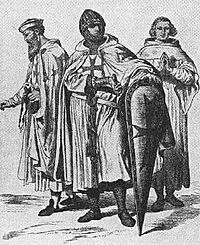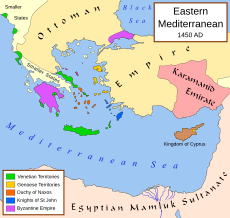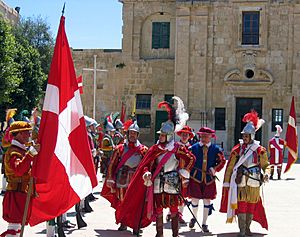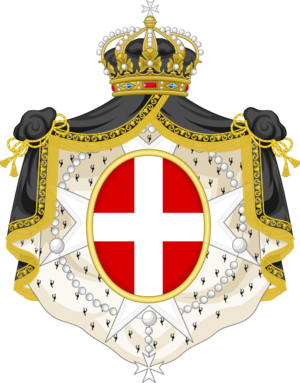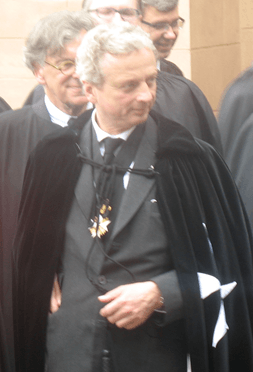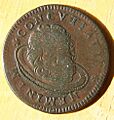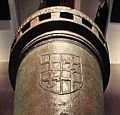Knights Hospitaller facts for kids
Quick facts for kids
|
|
|---|---|
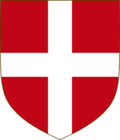 
Coat of arms and the eight-pointed cross used by Hospitallers during the Crusades.
|
|
| Active | 15 February 1113–present |
| Allegiance | |
| Type | Catholic military order |
| Headquarters | |
| Nickname(s) | The "Religion" |
| Patron |
|
| Colors |
|
| Engagements |
List
|
| Commanders | |
| First Grand Master | Gerardo Sasso |
| Current Grand Master | John T. Dunlap |
| Notable commanders |
Jean Parisot de Valette Philippe Villiers de L'Isle-Adam Garnier de Nablus |
The Knights Hospitaller were a Catholic military order. They started in the Kingdom of Jerusalem in the 12th century. Their main bases were in Jerusalem and Acre until 1291. After that, they moved to Kolossi Castle in Cyprus (1302–1310), then to the island of Rhodes (1310–1522), and later to Malta (1530–1798).
The Hospitallers began in the early 1100s. Merchants from Amalfi had built a hospital in Jerusalem. It was for sick, poor, or injured Christian pilgrims traveling to the Holy Land. Blessed Gerard, a lay brother, became its leader. After Christians took Jerusalem in 1099 during the First Crusade, the Hospitallers became more important. Pope Paschal II officially recognized them as a separate order in 1113.
The Order of Saint John became a military group in the 1120s and 1130s. They hired knights who later became Hospitallers. The Pope gave them a special charter. This made them a military religious order. Their job was to care for and defend the Holy Land. They fought in the Crusades until 1291. After Islamic forces took back the Holy Land, the knights moved to Rhodes. They ruled Rhodes as their own land. Later, they moved to Malta. They also controlled the city of Tripoli in North Africa for 20 years. They even briefly owned four Caribbean islands in the mid-1600s. They gave these islands to France in the 1660s.
The knights faced challenges during the Protestant Reformation. Some parts of the order in Germany and the Netherlands became Protestant. These groups largely separated from the Catholic main order. They remain separate today. The order was also stopped in England and other parts of northern Europe. Napoleon's capture of Malta in 1798 further weakened them. After this, they spread across Europe.
Today, five main groups continue the traditions of the Knights Hospitaller. They all recognize each other. These are the Sovereign Military Order of Malta, the Most Venerable Order of the Hospital of Saint John, the Bailiwick of Brandenburg of the Chivalric Order of Saint John, the Order of Saint John in the Netherlands, and the Order of Saint John in Sweden.
Contents
History of the Knights Hospitaller
How the Order Began
In 603, Pope Gregory I asked Abbot Probus to build a hospital in Jerusalem. This hospital was for Christian pilgrims. In 800, Emperor Charlemagne made the hospital bigger. But in 1009, a ruler named al-Hakim bi-Amr Allah destroyed it.
Later, in the 1000s, merchants from Amalfi got permission to build a new monastery in Jerusalem. It was near the Church of the Holy Sepulchre. Benedictine monks ran this place. They helped Christian pilgrims. As more pilgrims came, the monks built two hospitals around 1060. One was for men and one for women. The men's hospital was called the Hospital of St John.
By the time of the First Crusade in 1099, the Hospital of St John was well known. It was seen as separate from the monastery. The monks at the hospital wanted to give the best care to the poor. Godfrey of Bouillon, a leader of the First Crusade, gave them money before he died in 1100.
The Pope officially recognized the Hospitaller Order. On February 15, 1113, Pope Paschal II issued a special document. It was called Pie postulatio voluntatis. This document was for Blessed Gerard, the head of the Hospital of St John. The Pope put the hospital under his own power. He also said it did not have to pay taxes on its land. He gave the brothers the right to choose their own leader.
Becoming a Military Order
Gerard gained land and money for his order. Under his successor, Raymond du Puy, the hospital grew. It became a large infirmary. At first, the Hospitallers cared for pilgrims and others, including Muslims and Jews. But soon, they also started providing armed guards for pilgrims. Eventually, they became a strong military group. They became military without losing their goal of helping people.
The Hospital of St John might have hired knights for safety after the First Crusade. In the 1120s, knights in Europe left their weapons to the Hospitallers in their wills. By the early 1140s, Pope Innocent II mentioned that the Hospitallers had "servants" to protect pilgrims. The Knights Templar order was founded around 1119-1120. It is likely the Hospitallers were inspired to have their own knights.
Raymond du Puy, who became the leader in 1120, is known for starting the military side of the Order. He decided that Hospitallers could fight to defend the kingdom. The Knights Hospitaller had two types of fighting members: knights and sergeants. In 1130, Pope Innocent II gave the order its coat of arms. It was a plain silver cross on a red background. This helped tell them apart from the Templars. The other symbol, the "eight-pointed cross," later became known as the Maltese cross.
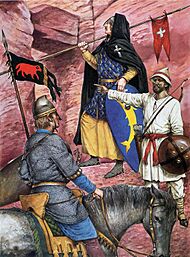
King Fulk of Jerusalem built castles to protect the kingdom's southern border. In 1136, he let the Hospitallers manage one of them, the castle of Bethgibelin. This castle helped them protect the pilgrim route. Over the next few decades, the Order received more castles and towns. Nobles gave them these places because they needed help defending them. This included the famous Krak des Chevaliers in 1142. By 1180, the Hospitallers had about 25 castles. They also built new castles or repaired old ones.
One of their first battles was the Siege of Ascalon in 1153. After some Knights Templar were killed, King Baldwin III of Jerusalem wanted to give up. But Raymond du Puy convinced him to keep fighting. The fort surrendered to the Crusaders.
The Hospitallers and the Knights Templar became the strongest military orders in the Holy Land. In 1248, Pope Innocent IV approved a special uniform for the Hospitallers in battle. They wore a red coat over their armor with a white cross on it.
The Hospitallers built many strong Christian forts in the Holy Land. They held seven large forts and 140 other properties. Their main power bases were Krak des Chevaliers and Margat in Syria. The Order's properties were divided into areas called priories.
Moving to Cyprus and Rhodes
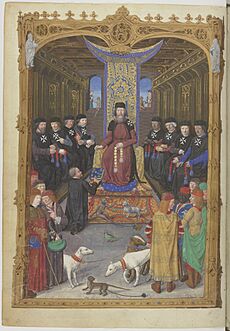
After the Kingdom of Jerusalem fell in 1291, the Knights moved to the Kingdom of Cyprus. They found themselves getting involved in Cypriot politics. So, their leader, Guillaume de Villaret, planned to get their own land. He chose Rhodes, which was then part of the Byzantine Empire. He also divided the order into eight "tongues" or langues. These were based on different regions like Aragon, England, and France.
Guillaume's successor, Foulques de Villaret, carried out the plan to take Rhodes. On August 15, 1310, after four years of fighting, the city of Rhodes surrendered to the knights. They also gained control of nearby islands. Soon after, in 1312, Pope Clement V closed down the Knights Templar. Much of the Templars' property was given to the Hospitallers. On Rhodes, the Hospitallers became known as the Knights of Rhodes. They had to become even more of a military force.
In the 1400s, the knights often fought with Barbary pirates. They also survived two invasions by strong Muslim forces. One was by the Sultan of Egypt in 1444. The other was by Ottoman Sultan Mehmed the Conqueror in 1480.
In 1522, a huge force arrived. Sultan Suleiman the Magnificent brought up to 100,000 men to Rhodes. The knights, led by Grand Master Philippe Villiers de L'Isle-Adam, had only about 7,000 fighters. The siege lasted six months. The defeated Hospitallers who survived were allowed to leave for Sicily. Even though they lost, both Christians and Muslims respected Phillipe Villiers for his bravery.
The Knights of Malta
After seven years without a home, Pope Clement VII made a deal in 1530. He worked with Charles V, Holy Roman Emperor, who was King of Spain and Sicily. Charles V gave the knights Malta, Gozo, and the North African port of Tripoli. In return, the knights had to send him one Maltese falcon every year.
The knights stayed in Malta for 268 years. They turned the island into a strong and rich place. Its capital city, Valletta, became known as Superbissima, meaning "Most Proud." However, the local people of Malta were not always happy with the knights. They felt the knights were arrogant. Most knights were French and did not let Maltese people join the order. But the two groups lived together peacefully. The knights helped the economy and protected against attacks.
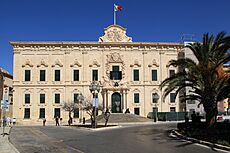
The knights quickly built hospitals in Malta. French became the official language. They also built strong forts, watch towers, and churches. The building of Valletta, named after Grand Master La Valette, began in 1566. It became the home port for one of the strongest navies in the Mediterranean. The Sacra Infermeria, their hospital, could hold 500 patients. It was known as one of the best in the world. Valletta also became a center for art and culture.
In 1565, Sultan Suleiman sent a huge invasion force of about 40,000 men. They came to besiege the 700 knights and 8,000 soldiers in Malta. This event is known as the Great Siege of Malta.
At first, the battle went badly for the Hospitallers. Many cities were destroyed, and about half the knights were killed. On August 18, the knights were in a desperate situation. But Grand Master Jean Parisot de Valette refused to give up.
On September 1, the Ottomans made their last big attack. But their soldiers were tired and losing hope. They heard that Sicilian reinforcements were arriving. Not knowing the force was small, they ended the siege and left on September 8. The Great Siege of Malta was a huge victory for the knights. When the Ottomans left, only 600 knights could still fight. The Ottomans had lost about 25,000 men. After the siege, a new city was built. It was named Valletta, in honor of the Grand Master.
Changes in Europe
The Order lost many of its lands in Europe during the Protestant Reformation. The English branch's property was taken in 1540. The German branch became Protestant but still paid money to the Order until 1812.
The Knights of Malta were also important in the Imperial Russian Navy and the French Navy. In 1651, the knights bought the Caribbean islands of Sainte-Christophe, Saint Martin, and Saint Barthélemy. They also bought Saint Croix. But by 1665, the order sold their Caribbean lands to France.
The French National Assembly abolished feudalism in France in 1789. This also ended the Order in France. The French government took the Order's properties in France in 1792.
Losing Malta and Decline
Napoleon captured Malta in 1798 during his trip to Egypt. Napoleon demanded that his ships be allowed into the port. The Grand Master, Ferdinand von Hompesch zu Bolheim, refused to let more than two ships in at a time. Napoleon immediately attacked Malta. French soldiers landed on June 11 and fought fiercely. The Maltese in the west had to surrender.
Napoleon then negotiated with Valletta. The Grand Master surrendered to the much larger French forces. Hompesch left Malta on June 18 and resigned on July 6, 1799.
The knights were scattered. But the order continued in a smaller way. The Russian Emperor, Paul I, gave many knights shelter in Saint Petersburg. This led to a Russian tradition of the Knights Hospitaller. The knights in Saint Petersburg chose Tsar Paul as their Grand Master.
By the early 1800s, the order was very weak. Most of its money came from the Russian Grand Priory. From 1805 to 1879, the Order was led by Lieutenants, not Grand Masters. Then, Pope Leo XIII brought back a Grand Master. This helped the order become strong again as a group focused on helping people.
In 1806, the Swedish government offered the island of Gotland to the Order. But the offer was turned down. This was because it would mean giving up their claim to Malta.
A very old hospital of Saint John, built between 1099 and 1291, was found again in Jerusalem. It could hold up to 2,000 patients from all religions. Jewish patients even received kosher food. It also served as an orphanage.
Who Continues the Knights Hospitaller Today?
Today, several groups continue the work of the Knights Hospitaller. The main one is the Sovereign Military Order of Malta, based in Rome. It is recognized by over 100 countries. Other groups are part of the Alliance of the Orders of Saint John of Jerusalem. These include the German, Dutch, and Swedish branches, and the British Most Venerable Order of the Hospital of St. John of Jerusalem.
The Sovereign Military Order of Malta
In 1834, the order settled in Rome. Helping people in hospitals became its main focus again. The Order greatly increased its hospital and welfare work during World War I and World War II.
The Sovereign Military Order of Malta (SMOM) is a Catholic religious order. It is the oldest surviving order of chivalry. Many international groups recognize its special status. It has diplomatic relations with 112 countries. It even issues its own passports, currency, and stamps.
The SMOM is active in 120 countries. It has many hospitals, medical centers, and first aid groups. Its 13,500 members and 95,000 volunteers help the poor, sick, elderly, and disabled. They also help victims of wars and natural disasters. They provide medical aid and care for refugees.
The Sovereign Military Order of Malta has a presence in Malta. They have an agreement with the Maltese Government. This gives them the use of Fort St. Angelo for 99 years. After being restored, the Fort now hosts historical and cultural events about the Order.
Other Orders of Saint John
During the Reformation, some German groups of the Order became Protestant. They continued as the Order of Saint John of the Bailiwick of Brandenburg. This order is protected by Germany. Its leader is almost always from the royal family of Prussia. This Protestant branch has spread to many countries around the world.
The Dutch and Swedish branches became independent after World War II. They are now separate orders. Their own monarchs protect them.
All three Protestant orders (German, Dutch, and Swedish) work together. They formed the Alliance of the Orders of Saint John of Jerusalem in 1961. These orders are separate from the Catholic Sovereign Military Order of Malta, but they cooperate.
The Most Venerable Order of Saint John
In England, King Henry VIII took almost all the property of the Knights Hospitaller in the 1500s. This effectively ended the English branch of the order.
In 1831, a British order was re-created. It later became known as the Most Venerable Order of Saint John. Queen Victoria officially recognized it in 1888. This order then grew throughout the British Empire and the United States. Today, its most famous activities are the St John Ambulance Brigade and the Saint John Eye Hospital in Jerusalem. Unlike the older orders, this British group does not only accept Christians.
Leadership and Structure
Headquarters and Main Roles
The highest leader of the Hospitallers was the Grand Master. He was the commander-in-chief. The Grand Commander was second in charge. The Marshal was in charge of military matters. This included getting armor, weapons, and horses.
The main headquarters of the Hospitallers was called the convent. Its senior officials included:
- Grand Master: The overall leader.
- Seneschal: Second-in-command.
- Marshal: In charge of military affairs.
- Preceptor: Managed administration and supplies.
- Hospitaller: Managed the main hospital.
- Prior: Responsible for the church at the convent.
- Draper: In charge of uniforms.
- Treasurer: Responsible for money.
Later, they also had a Turcopolier (in charge of local helper forces) and an Admiral (who led the navy).
Ranks of Members
The earliest members were called "brothers." They were also called Hospitallers. By the time of the First Crusade, they were known as "poor brothers" of the hospital. Over time, the Order had three main types of members:
- Priest brothers: Who handled religious duties.
- Knight brothers: Who were the fighting knights.
- Sergeant brothers: Who were also fighters, often hired at first.
Knights were part of the Order by the 1140s. Sergeants were not initially "brothers" but were hired soldiers. By 1204, both knight brothers and sergeant brothers were officially recognized as members of the Order.
Images for kids
-
Krak des Chevaliers, a castle in Syria that the Hospitallers owned.
-
A 1742 coin from the Knights Hospitaller, showing the head of John the Baptist.
-
A view of Fort Saint Angelo in Malta, which belongs to the Sovereign Military Order of Malta.
See also
 In Spanish: Orden de San Juan de Jerusalén para niños
In Spanish: Orden de San Juan de Jerusalén para niños



